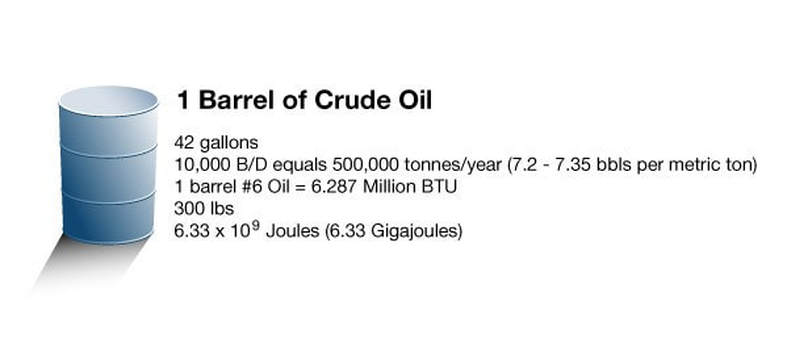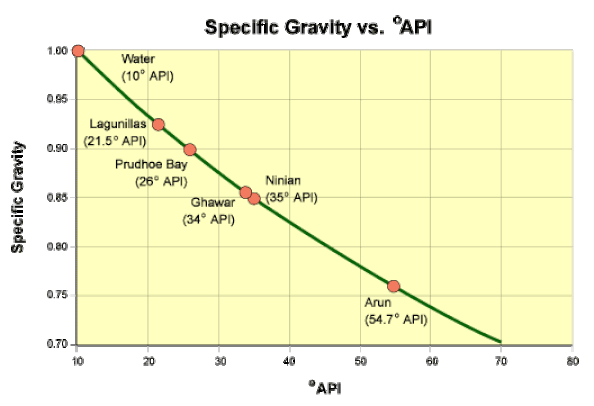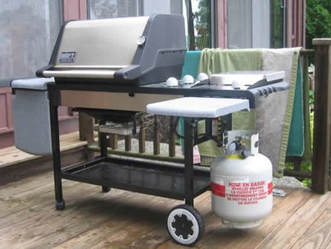Depending on the purpose of the measurement-and on regional or national preferences - oil, gas, gas liquids and their products may be measured in terms
of volume or weight For example:
of volume or weight For example:
- Petroleum engineers, particularly those working in the Western Hemisphere, measure oil and gas volumes to answer questions like, "How much oil or
- gas do I have in my reservoir? How much can be produced during the life of the field? What is the daily production rate?"
- In contrast, ship owners would want oil shipments to be measured in weight to avoid overloading their tankers.
Crude Oil Measurement
The standard volume unit for crude oil measurement, the 42-gallon barrel ("bbl"), dates back to the 1860s, when Pennsylvania producers actually stored and transported petroleum in wooden barrels. To this day you may hear a petroleum engineer say, "This field has reserves of 1 billion barrels and we expect to produce it for 20 years at a design rate of 150,000 bbl/day." In countries that use the SI or "metric" system, oil volumes may be measured in metric tonnes.
In Europe and especially the former Soviet Union, crude oil is measured in terms of weight and expressed in metric tonnes ("mt"), where one mt equals 2,204 lb. Although crude oils vary in density, a good "average" volume-to-weight conversion is 7.33 bbls/mt. Based on this conversion factor, a Russian engineer would refer to production not as 150,000 bbl/day but as 20,464 mt/day.
The standard volume unit for crude oil measurement, the 42-gallon barrel ("bbl"), dates back to the 1860s, when Pennsylvania producers actually stored and transported petroleum in wooden barrels. To this day you may hear a petroleum engineer say, "This field has reserves of 1 billion barrels and we expect to produce it for 20 years at a design rate of 150,000 bbl/day." In countries that use the SI or "metric" system, oil volumes may be measured in metric tonnes.
In Europe and especially the former Soviet Union, crude oil is measured in terms of weight and expressed in metric tonnes ("mt"), where one mt equals 2,204 lb. Although crude oils vary in density, a good "average" volume-to-weight conversion is 7.33 bbls/mt. Based on this conversion factor, a Russian engineer would refer to production not as 150,000 bbl/day but as 20,464 mt/day.
Oil Quality: API Gravity
A crude oil's density is an important measure of its overall quality. This is because lighter oils are generally easier to produce and refine than heavy oils, and therefore tend to have higher value. Oil density is sometimes expressed in terms of its specific gravity, but more often is given as API gravity.
A crude oil's density is an important measure of its overall quality. This is because lighter oils are generally easier to produce and refine than heavy oils, and therefore tend to have higher value. Oil density is sometimes expressed in terms of its specific gravity, but more often is given as API gravity.
- The specific gravity (S.G.) of a liquid is defined as the density of that liquid divided by the density of fresh water. Fresh water has a density of 62.4 pounds per cubic foot. An oil with a density of 53 pounds per cubic foot, therefore, would have a specific gravity of (53/62.4), or 0.85. Fresh water, by definition, has a specific gravity of 1.0.
- The American Petroleum Institute (API) has developed a special measure that expresses oil density in terms of API gravity, or ºAPI. It is related to the specific gravity as follows: S.G. = 141.5/(131.5+ºAPI) or ºAPI = (141.5/S.G.) - 131.5
Correlation between specific gravity and°API gravity. Note the the API gravities of crude oils from different fields
Natural Gas Measurement
Natural gas is typically measured in terms of its volume at surface conditions and in thermal energy units. It is measured by weight only when it is in the liquid state (LNG). Because gas is compressible, its volume varies significantly with changes in temperature and pressure. In order for gas volume measurements to have any meaning, they have to have some standard frame of reference. For this reason, the industry has established standard conditions for referring to all gas volumes
Natural gas is typically measured in terms of its volume at surface conditions and in thermal energy units. It is measured by weight only when it is in the liquid state (LNG). Because gas is compressible, its volume varies significantly with changes in temperature and pressure. In order for gas volume measurements to have any meaning, they have to have some standard frame of reference. For this reason, the industry has established standard conditions for referring to all gas volumes
Unit of Gas Volume Measurement |
Standard
Conditions |
Area of Common Usage |
Standard
Cubic Foot (SCF) |
14.696 psi (1 atmosphere) and 60°F |
USA, Latin America, Africa, Middle East. |
Standard Cubic Meter (Sm3) |
100 kPa (0.987 atmosphere) and 15°C |
Europe, Canada, Russia. |
*Conversions: 1 m3 = 35.315 ft3; 1 ft3 = 0.0283 m3*
Gas Liquids and Petroleum Product Measurement
LNG (liquefied natural gas) is typically measured in metric tonnes or cubic meters. The normal conversion to volume units in the liquid state is that 1 mt equals 2.12 m3 or 79.5 ft3. When 1 tonne of LNG is vaporized to become natural gas it expands about 625 times to equal 1380 m3 or 48,700 ft3 at atmospheric conditions.
LPG and petroleum products are generally measured in gallons in the United States and certain other Western Hemisphere countries, and kiloliters or metric tonnes in Canada, and in Europe and other Eastern Hemisphere countries. Their conversion from volume to weight will depend on the density of the product. Thus, one metric tonne of propane is equal to 521 gallons or 1.97 kiloliters, while one metric tonne of fuel oil is equal to 281 gallons or 1.064 kiloliters.
LPG must be stored at an elevated pressure or be refrigerated in order to remain in the liquid state, and so it is measured at these high-pressure and/or low-temperature conditions rather than at "atmospheric" conditions.
Propane must be stored at a pressure of 200 psi or be cooled to -44°F (-42°C) in order to remain in the liquid state.



